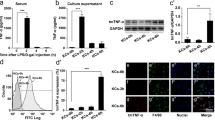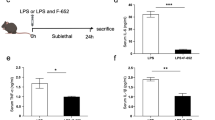Summary
Studies were conducted to investigate possible roles of tumor necrosis factor (TNF) and interleukin-1 (IL-1) in liver cell necrosis/fatal hepatitis in mice which were injected withPropionibacterium acnes (P.acnes) and subsequently 7 days later with a small dose of lipopolysaccharide-endotoxin (LPS). Higher serum levels of TNF were observed in the model, and enhanced production of both TNF and IL-1 was also found in hepatic as well as splenic adherent cells that were isolated from mice pretreated withP.acnes and were stimulated by LPSin vitro. When TNF substituted for LPS in the model, fatal hepatitis was also induced within 24 hrs, although the replacement of LPS by IL-1 resulted in no lethality. Moreover, when a combination of a near non-lethal doses of TNF and IL-1 substituted for LPS, 100% lethality was observed within 4 hrs. These results strongly suggest that both TNF and IL-1 are crucial soluble factors which are released by infiltrating macrophages in both liver and spleen, and are responsible for the development of liver cell necrosis/fatal hepatitis. In particular, TNF is one of the principal mediators of liver injury and IL-1 may potentiate the lethal effect of TNF in an LPS-related experimental model of massive liver cell necrosis.
Similar content being viewed by others
References
Le J, Vilcek J: Tumor necrosis factor and interleukin 1: Cytokines with multiple overlapping biological activities. Lab Invest 1987;56:234–248
Beutler B, Cerami A: Cachectin: more than a tumor necrosis factor. N Engl J Med 1987; 316: 379–385
Muto Y, Nouri-Aria KT, Meager A, et al: Enhanced tumor necrosis factor and interleukin-1 in fulminant hepatic failure. Lancet 1988;II:72–74
Ferluga J, Allison AC: Role of mononuclear infiltrating cells in pathogenesis of hepatitis. Lancet 1978;II:610–611
Lehmann V, Freudenberg MA, Galanos C, et al: Lethal toxicity of lipopolysaccharide and tumor necrosis factor in normal and D-galactosamine-treated mice. J Exp Med 1987;165:657–663
Mizoguchi Y, Tsutsui H, Miyajima K, et al: The protective effects of prostaglandin E1 in an experimental massive hepatic cell necrosis model. Hepatology 1987;7:1184–1188
Doolittle RL, Richter GW: Isolation and culture of Kupffer cells and hepatocytes from single rat livers. Lab Invest 1981;45:558–566
Gery I, Gershon RK, Waksman BH: Potentiation of the T-lymphocyte response to mitogens. I. The responding cell. J Exp Med 1972;136:128–142
Ohnishi H, Moriwaki H, Nagura K, et al: Experimental studies on the pathogenesis of fulminant hepatitis with respect to tumor necrosis factor (TNF). Acta Hapat Jap 1989;30:103–104
Author information
Authors and Affiliations
Additional information
This study was supported in part by a grant (61-63-3) from the Research Group of Intractable Hepatitis sponsored by the Ministry of Health and Welfare of Japan.
Rights and permissions
About this article
Cite this article
Liu, P., Ohnishi, H., Moriwaki, H. et al. Enhanced tumor necrosis factor and interleukin-1 in an experimental model of massive liver cell necrosis/fatal hepatitis in mice. Gastroenterol Jpn 25, 339–342 (1990). https://doi.org/10.1007/BF02779448
Received:
Accepted:
Issue Date:
DOI: https://doi.org/10.1007/BF02779448




